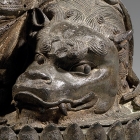J.J. Lally & Co., Oriental Art / New York City, New York
MenuPast Exhibition
Buddhist Sculpture from Ancient China
March 10-31, 2017
22.
A BRONZE FIGURE OF THE SIMHANADA AVALOKITESVARA
(SHI HOU GUANYIN)
Yuan – Early Ming Dynasty, 14th – 15th Century
the ‘Bodhisattva of the Lion’s Roar’ shown seated in the posture of royal ease on the back of a plump recumbent lion, wearing loose robes cast with floral borders, draped with scarves and adorned with jewels and beaded chains on the chest, and with more beaded chains down the back, on the shins and on the arms, the ears with heavy earrings in long lobes, the hair pulled up into a topknot behind an elaborate crown centered with a small figure of Amitābha Buddha and falling in plaits over the shoulders, the separate original base with three rows of lotus petals on the rounded sides above a border of swirling waves cast on the recessed foot, with lustrous black patina and scattered remains of pigment and gilding all over.
Height 20 3⁄4 inches (52.7 cm)
Provenance
From the Collection of Captain S.N. Ferris Luboshez, U.S.N. (1896-1984), acquired by him in Shanghai before 1949.
The Simhanada Avalokitesvara can be identified by the small seated Buddha at the center of the crown and the bodhisattva’s royal ease posture sitting on the recumbent lion. Compare the painted wood Simhanada Avalokitesvara illustrated by Leidy and Strahan in Wisdom Embodied: Chinese Buddhist and Daoist Sculpture in the Metropolitan Museum of Art, New York, 2010, pp. 156-157, no. 40, described as Ming dynasty, late 15th – early 17th century, where the author infers that this rare iconography may have been introduced to China around the twelfth century.
A gilt bronze seated figure of the ‘Water-Moon Guanyin’ with similar long braids and jewelry, in the collection of the Royal Ontario Museum, Toronto, is illustrated by Watt (ed.) in the catalogue of the special exhibition The World of Khublai Khan: Chinese Art in the Yuan Dynasty, New York, 2010, p.115, figure 149, where the author describes it as 14th century based on the characteristic “… high and complicated headdress with long matted braids more typically seen on contemporaneous Nepali and Tibetan works.”
Another gilt bronze figure of the ‘Water-Moon Guanyin’ with similar long braids and elaborate jewelry, from the Avery Brundage Collection, is illustrated by Lefebvre d'Argencé (ed.) in Chinese, Korean and Japanese Sculpture: the Avery Brundage Collection, Asian Art Museum of San Francisco, San Francisco, 1974, pp. 292-293, no. 154, described as late Yuan or early Ming (14th century A.D.).
Compare also the large Yuan dynasty Qingbai porcelain bodhisattva figures with very similar elaborate braids and jewelry, in the Metropolitan Museum of Art, illustrated by Valenstein, A Handbook of Chinese Ceramics, New York, 1975, p. 127 with description on pp. 125-126; in the Rietberg Museum, Zurich, illustrated by Brinker and Fischer in the catalogue, Treasures from the Rietberg Museum, Asia Society, New York, 1980, pp. 143-145, no. 54; in the Capital Museum, Beijing, discovered in 1969 at the ancient site of Yuan dynasty capital near Beijing, illustrated in Zhongguo taoci quanji: Yuan xia (The Complete Works of Chinese Ceramics: Yuan II), Shanghai, 2000, p. 31, no. 1; and in the Victoria and Albert Museum, London, illustrated in the same volume, ibid, p. 33, no. 3.
元 – 明初 銅獅吼觀音 高 52.7 厘米
出處 海軍上校 Luboshez 舊藏,1949 年以前購於上海
